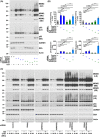Ubiquitin receptors play redundant roles in the proteasomal degradation of the p53 repressor MDM2
- PMID: 35735670
- PMCID: PMC9796813
- DOI: 10.1002/1873-3468.14436
Ubiquitin receptors play redundant roles in the proteasomal degradation of the p53 repressor MDM2
Abstract
Much remains to be determined about the participation of ubiquitin receptors in proteasomal degradation and their potential as therapeutic targets. Suppression of the ubiquitin receptor S5A/PSMD4/hRpn10 alone stabilises p53/TP53 but not the key p53 repressor MDM2. Here, we observed S5A and the ubiquitin receptors ADRM1/PSMD16/hRpn13 and RAD23A and B functionally overlap in MDM2 degradation. We provide further evidence that degradation of only a subset of ubiquitinated proteins is sensitive to S5A knockdown because ubiquitin receptor redundancy is commonplace. p53 can be upregulated by S5A modulation while degradation of substrates with redundant receptors is maintained. Our observations and analysis of Cancer Dependency Map (DepMap) screens show S5A depletion/loss substantially reduces cancer cell line viability. This and selective S5A dependency of proteasomal substrates make S5A a target of interest for cancer therapy.
Keywords: ADRM1/PSMD16/hRpn13; MDM2; S5A/PSMD4/hRpn10; p53/TP53; proteasomal ubiquitin receptor; redundancy.
© 2022 The Authors. FEBS Letters published by John Wiley & Sons Ltd on behalf of Federation of European Biochemical Societies.
Figures







Similar articles
-
The degradation of p53 and its major E3 ligase Mdm2 is differentially dependent on the proteasomal ubiquitin receptor S5a.Oncogene. 2014 Sep 18;33(38):4685-96. doi: 10.1038/onc.2013.413. Epub 2013 Oct 14. Oncogene. 2014. PMID: 24121268 Free PMC article.
-
Suppression of the deubiquitinating enzyme USP5 causes the accumulation of unanchored polyubiquitin and the activation of p53.J Biol Chem. 2009 Feb 20;284(8):5030-41. doi: 10.1074/jbc.M805871200. Epub 2008 Dec 19. J Biol Chem. 2009. PMID: 19098288 Free PMC article.
-
The ubiquitin-interacting motifs of S5a as a unique upstream inhibitor of the 26S proteasome.Biochem Biophys Res Commun. 2009 Oct 30;388(4):723-6. doi: 10.1016/j.bbrc.2009.08.078. Epub 2009 Aug 18. Biochem Biophys Res Commun. 2009. PMID: 19695230
-
Dynamics in the p53-Mdm2 ubiquitination pathway.Cell Cycle. 2004 Jul;3(7):895-9. Epub 2004 Jul 2. Cell Cycle. 2004. PMID: 15254415 Review.
-
Mdm2 widens its repertoire.Cell Cycle. 2007 Apr 1;6(7):827-9. doi: 10.4161/cc.6.7.4086. Epub 2007 Apr 28. Cell Cycle. 2007. PMID: 17377491 Review.
References
-
- Kwon YT, Ciechanover A. The ubiquitin code in the ubiquitin‐proteasome system and autophagy. Trends Biochem Sci. 2017;42(11):873–86. - PubMed
-
- Kambhampati S, Wiita AP. Lessons learned from proteasome inhibitors, the paradigm for targeting protein homeostasis in cancer. Adv Exp Med Biol. 2020;1243:147–62. - PubMed
Publication types
MeSH terms
Substances
Associated data
Grants and funding
LinkOut - more resources
Full Text Sources
Research Materials
Miscellaneous

